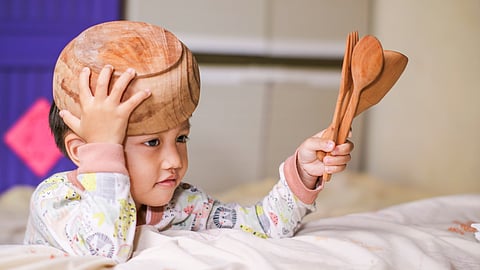Summer break’s almost over—has your child checked off these must-do activities?
Building forts and friendships: A summer checklist for children

Ask me to build a blanket fort today, and I might just end up buried under it.
But at the age of six, we knew. We pottered around efficiently unearthing sofas, cushions, taking blankets from our parents rooms and then spent hours ‘building’ forts. My mother would walk in and sigh, “Okay, that’s why all the bed-clothes are missing.”
Fort-building probably came quicker to us than mathematics. It was just one of the summer childhood essentials and it drowned out the drudgery of holiday homework.
The blanket fort tradition continues to still hold strong as UAE mums like Anjali Nair vouches. Her checklist for her children includes: Making sure they play games, different and engaging fun games that will have them running through the house shrieking and squabbling. Afterall, what is childhood for? "I want them to always just have fun, play games, and no screens. They are only six, and I have no intention of letting them near phones or tablets right now," she says.
While every family has their own way of spending summer holidays, experts like Adam Griffin, CEO and medical director of Dubai's Hakkini, have spotted patterns in what truly makes a summer memorable for children.
Activities like building a blanket fort or writing a letter to a friend are just two great examples of age-appropriate, natural play that’s packed with developmental benefits
Letters to laughter
As Griffin explains, “Activities like building a blanket fort or writing a letter to a friend are just two great examples of age-appropriate, natural play that’s packed with developmental benefits.” These kinds of activities give children the chance to be creative, make their own decisions, connect with others, and express their thoughts, all of which can really help their mental health in the long run.
And, a blanket fort isn’t just a blanket fort. It involves planning, motor skills and problem solving (cue to feel good about yourself), and when finished, it becomes a space of their own. They feel safe and in control, which is calming to their nervous system. Similarly, writing a letter gives children a way to connect with others and express how they feel, while also learning how to communicate. “Then they get the bonus of anticipation and practicing patience as they wait for the return letter from their friend,” he says.
And, none of this feels like work. It’s the best kind of play. “And once children get used to flexing those creative muscles, they’ll start coming up with their own brilliant ideas, often better than anything we could plan for them,” he says.
Using items around the house for pretend play
Make the best use of what's around you. It could be a cardboard box, egg-carton or just a simple water bottle. Let them imagine and run free with it. Your job as a parent isn’t to orchestrate— it’s to observe, support, and join in when invited. Say yes to their ideas, offer new prompts when they’re stuck ‘What if the vacuum was a time machine?’, and most importantly,
How to have a screen-free summer
You don’t need screen-time.
The best kind of summer learning doesn’t involve a worksheet, it looks like scooter races, obstacle courses, garden treasure hunts, pillow stack balance games, or turning your hallway into a bowling alley.
As Griffin says, movement and creativity aren’t just good for keeping children busy, they help build coordination, core strength, attention, and executive function. These are the building blocks that children rely on when they’re back in class, trying to sit still, follow instructions, and stay focused.
Instead of screens or worksheets, think:
•A scavenger hunt with clues that sneak in reading and problem-solving
•A kitchen “cooking show” to practice motor skills, sequencing, language, and following instructions
•A ‘DIY Olympics’ with sock throws, crab walks, and balance challenges
It’s all about making it fun, letting the child take the lead, and keeping things light and playful.
The long summer break is when we often see children, especially those with additional needs, lose a bit of ground in terms of motor skills, attention, or emotional regulation. This is often called the ‘summer slide,’” he says. “That’s why I always say: a good summer makes the new school year a lot easier.
It doesn't feel like a chore
Keeping children active, engaged, and feeling good in themselves over the break means they return to school in a much better place, calmer, more confident, and ready to learn. And the best part: It doesn’t feel like a chore.
So, what does his summer checklist suggest? Trying to cook, Dance routines, swimming, riding a bike, drawing a map of an imaginary country, and so many more. Dubai-based media mum Katherine O’Malley says that her eight-year-old loves the last one, especially: Imagining a new country, and language. “He spent days drawing maps, and told us about it everyday. Apparently, it’s an unknown country near Antarctica,” she says.
So, did your child run free with their imagination this summer?
Sign up for the Daily Briefing
Get the latest news and updates straight to your inbox







